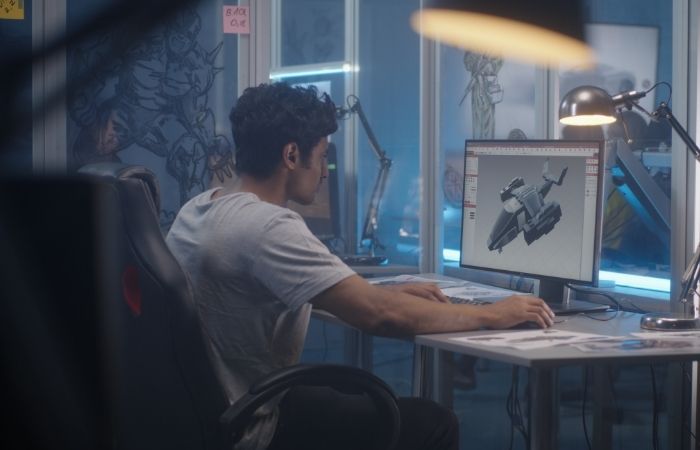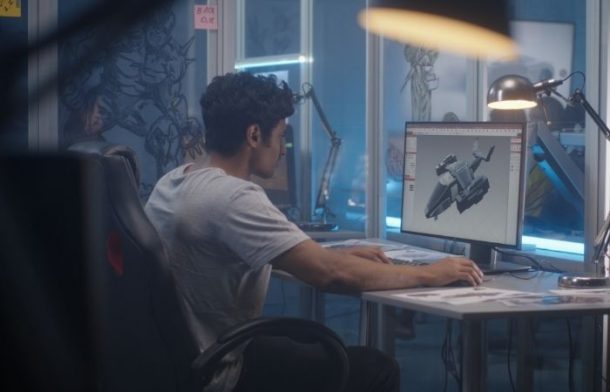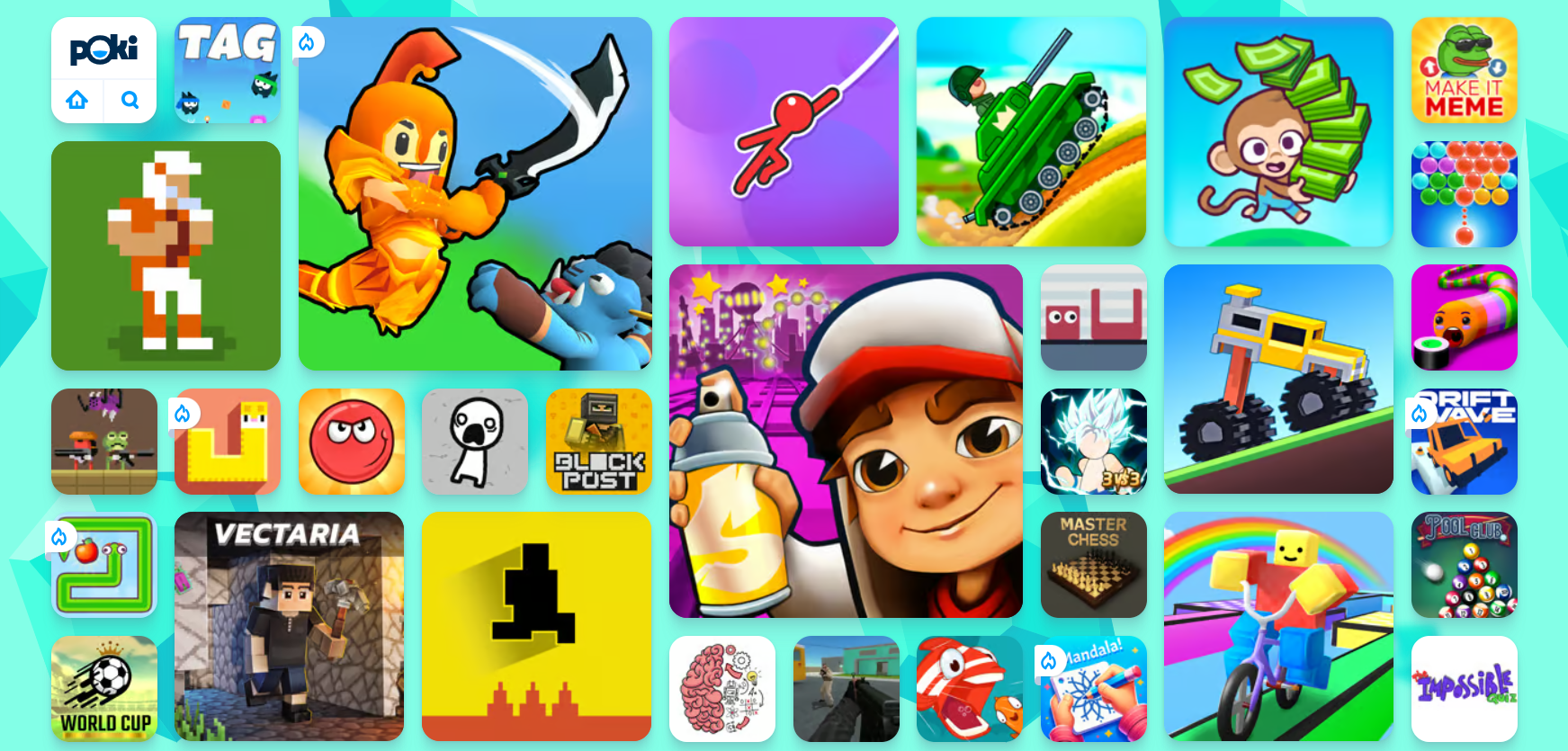Guides
Your Guide to Designing Your Own Video Game


Video games have been a staple of popular culture for decades, since the early days of Pong to the more complex and innovative games of today. What started as a simple genre has become multi-faceted with multiple sub-genres.
There are so many video game creators in the industry, but there is always room for more, with millions streaming and purchasing games to play in their homes and with friends. There are genres to fit every style and personality, from puzzles and party games to detailed multi-player and role-playing games.
When it comes to designing your own video game, there are many options to choose from and genres to work with — but they all have a few key things in common. Understanding the core features of a game and what players are looking for is key to creating a game that stands on its own in a competitive market.
Explore our guide for designing your own video game.
Develop a Story
When it comes to video games, the story is often one of the biggest draws for players, particularly if the game falls under the role-playing or multi-player category. When developing your story, it’s important to start small and grow your idea to ensure you’re allowing the story to fully develop. Players can follow along once the final product is complete.
In many cases, video games are designed to tell a story and act as an escape for its players. If you’re creating a game with a beginning, middle, and end, it’s important to make sure players can follow along with your story and feel like they’re active participants.
Visual Engagement
No matter what type of entertainment you’re creating, whether it’s a video game or a clothing line like you’d see in the Azzyland’s shop, having attractive visuals is key to keeping your audience engaged. While your graphics do not have to be state-of-the-art to accomplish their goal, you want to make sure you’re using the highest quality visuals you can create. After all, video games are meant to be an escape for many, and the visual elements of a game are essential to that process.
Balance Challenges with Rewards
When you’re playing a video game, it can feel frustrating when you’ve accomplished a feat or solved a problem, and the reward you’re given does not match the level of complexity of the completed challenge.
Having a challenge-reward balance ensures each player feels like they are making the most of the time and effort it takes to play your game and keeps them motivated to continue to complete each challenge that lies ahead.
Accurate Testing
As a video game developer, it’s your responsibility to test your game during multiple stages before it becomes available to purchase or stream. Whether you’re testing the game yourself or working with a third-party company, regular testing ensures any bugs or issues are able to be resolved before the game becomes widely available and ensures a quality player experience.
Gamers are more likely to stay engaged with your game if they aren’t tasked with dealing with glitches or obvious bugs that take away from the experience of playing the game.
Guides
Sims 4 Acting Skill Cheat [Acting Skill Guide]

The Sims 4 offers so many skills that it is conceivable not to learn them all.
If you want the best SIM, you can try to teach them every skill available. With such a short lifespan, cheats can help your SIM become the best.
You can use these tricks to boost a Sim’s talent to the appropriate level; you can even max out the skill, transforming it into an instant pro.

Also Read: Pokemon Go Mewtwo Location : Secret Hack Finally Revealed!
How To Enable Cheats
If you’ve used cheats before, you’re probably familiar with how to enable them. If not, we’ll go through the processes quickly. First, depending on your console, press the buttons listed below.
- PC – Ctrl + Shift + C
- Mac – Command + Shift + C
- Console (Xbox and PlayStation) – All 4 Shoulder Buttons
This will open a white box where you can put “testingcheats true”. A notice should appear indicating that cheats are enabled; after this appears, you are ready to go!
How To Use Skill Cheats
The skill cheat format is the same for all skills in the game; you only need to modify the skill in question. The basic cheat arrangement can be seen below.
- stats.set_skill_level [Skill] [Level]
Let us use video game skills as an example. If you wish to raise your Sim’s gaming talents to level ten, use the following hack. This immediately raises the skill to level 10, and you will receive all associated awards.
- stats.set_skill_level Major_Video Gaming 10
Also Read: LoL ARAM Tier List: Best Champions Ranked Players
Cheats For Acting In The Sims 4

Not every talent name is simple. Furthermore, there are several categories of skills, such as major and minor. The cheats for boosting each skill to its maximum level are listed below, organized by kind.
Major Skill Cheats
These are the normal abilities you consider, such as cooking or piano. “Major_” must appear before the skill name to specify the skill category.
- Charisma– stats.set_skill_level Major_Charisma 10
- Comedy– stats.set_skill_level Major_Comedy 10
- Cooking– stats.set_skill_level Major_HomestyleCooking 10
- Fishing– stats.set_skill_level Major_Fishing 10
- Gardening– stats.set_skill_level Major_Gardening 10
- Gourmet Cooking-stats.set_skill_level Major_GourmetCooking 10
- Guitar– stats.set_skill_level Major_Guitar 10
- Handiness– stats.set_skill_level Major_Handiness 10
- Logic– stats.set_skill_level Major_Logic 10
- Mischief– stats.set_skill_level Major_Mischief 10
- Mixology– stats.set_skill_level Major_Bartending 10
- Painting– stats.set_skill_level Major_Painting 10
- Piano– stats.set_skill_level Major_Piano 10
- Photography– stats.set_skill_level Major_Photography 10
- Programming– stats.set_skill_level Major_Programming 10
- Rocket Science– stats.set_skill_level Major_Rocket Science 10
- Video Gaming– stats.set_skill_level Major_Video Gaming 10
- Violin– stats.set_skill_level Major_Violin 10
- Writing– stats.set_skill_level Major_Writing 10
- Baking– stats.set_skill_level Major_Baking 10
- Wellness– stats.set_skill_level Major_Wellness 10
- DJ Mixing– stats.set_skill_level Major_DJ Mixing 10
- Singing– stats.set_skill_level Major_Singing 10
- Pipe Organ– stats.set_skill_level Major_PipeOrgan 10
- Parenting– stats.set_skill_level Major_Parenting 10
- Veterinarian– stats.set_skill_level Major_Vet 10
- Archeology– stats.set_skill_level Major_Archaelogy 10
- Flower Arranging– stats.set_skill_level Major_FlowerArranging 10
- Acting– stats.set_skill_level Major_Acting 10
- Research and Debate– stats.set_skill_level Major_ResearchDebate 10
- Knitting– stats.set_skill_level Major_Knitting 10
- Rock Climbing– stats.set_skill_level Major_Rock Climbing 10
Also Read: Granblue Fantasy: Tier List
Minor & Misc. Skill Cheats
These skills do not belong in the major group and appear to be rather different. Furthermore, some of these skills are above or below 10 levels, so you must adjust the number used.
- Medium– tats.set_skill_level Minor_Medium 5
- Cross-Stitching– stats.set_skill_level Skill_CrossStitch 5
- Entrepreneur– stats.set_skill_level Minor_Entrepreneur 5
- Juice Fizzing– stats.set_skill_level Minor_JuiceFizzing 5
- Media Production– stats.set_skill_level Minor_Media 5
- Bowling– stats.set_skill_level Skill_Bowling 5
- Dancing– stats.set_skill_level Minor_Dancing 5
- Pet Training-stats.set_skill_level Skill_Dog 5
Can You Lower A Skill?

You can also use these tricks to decrease a skill. Fortunately, they are treated the same. For example, if a Sim is at level 8 in the Video Game skill, you can apply the following cheat to get them back to level 4.
- stats.set_skill_level Major_Video Gaming 4
Also Read: Best DPS Tier List in Final Fantasy XIV
Final Thoughts
Your sims’ success will be determined by their ability to confidently and professionally walk into an acting gig. Instead of having your sims practice their acting skills in the mirror for hours, why not just use these cheats to skip the boring and have some fun?
Guides
Pokemon Go Mewtwo Location : Secret Hack Finally Revealed!

So you’re one step closer to becoming the best trainer in the Pokemon Go league? Your next challenge is finding the mysterious Mewtwo and you’re struggling with it. Well by the end of this article that part of the problem is definitely getting solved.
Mewtwo is one of the legendary Pokemons – both in the game and the franchise. It is a psychic type pokemon which proves to be quite a challenge to many gamers in coveting it. And unlike other wild pokemon’s that you encounter on the go, finding a Mewtwo is quite the task.
But don’t worry, whether you’re just beginning your journey on Pokemon Go or you’re a seasoned traveler, in this article we will unleash all the hacks and routes by which you are definitely going to know the way to Pokemon Go’s Mewtwo’s Location.
How Many Types of Pokemon Go Mewtwo Exist?
Well, catching Mewtwo in Pokemon Go is definitely a bit of hard work and brains combined. Moreover, there is not one, but many types of Mewtwo that you could collect on Pokemon Go.
There are four versions of a Pokemon Mewtwo that you could collect. Yes, you heard that right, Pokemon Go has four variants of Mewtwo. So when you think of Pokemon Go Mewtwo Location – there are four locations, and four ways to find them.
Firstly, there is the normal Mewtwo, or the regular Mewtwo. These are found in raids and you need a similar and strong psychic type Pokemon to battle and capture one. Then there is the Shiny Mewtwo, that you also find in raids but they come rare.
There is also the Shadow Mewtwo. You need to work harder to find this rare type of Mewtwo Pokemon. To get a Shadow Mewtwo, you need to beat Team Go Rocket boss Giovanni. We will soon cover how you will be able to do this, so keep reading to find out.
And last but not the least, there is an Armored Mewtwo. Although to be fair, this Mewtwo type was exclusive to a 2019 Pokemon Go event. This Mewtwo is rarely seen in raids or other events; now on Pokemon Go. So while there is not a specific Pokemon Go Mewtwo Location for this kind, you don’t need to feel bad. The best bet to getting this Pokemon Mewtwo in your collection now is by trading with others on Pokemon Go.
Also Read: Pokémon Arceus Mobile
How to catch Pokemon Go Mewtwo?

So we have covered all bases on the different kinds of Pokemon Mewtwo you could find online on Pokemon Go. But how and where? What is the secret to Pokemon Go Mewtwo Location on the app?
Well, it might take some time and attempts in finding a Mewtwo on Pokemon Go, but the methods are fairly simple.
To find Regular Mewtwo in Pokemon Go there is one simple way. You need to find 5-star raid battles and defeat Mewtwo in those.
Firstly, you’ll need a Raid Pass to participate in a raid battle. Raid passes are found for free by spinning the Gym Photo Discs daily. And if you don’t want that, just purchase one in the game shop.
Also Read: Three Shiny Legendary Pokemon Up for Grab In UK
These high-difficulty encounters feature Mewtwo as the Raid Boss, requiring you to team up with other trainers to take it down. Keep an eye out for Raid Eggs appearing atop Gyms. A hatching Raid Egg with a silhouette featuring horns and a long tail most likely signifies a Mewtwo encounter. Make sure to have a high ranking psychic Pokemon such as Bug, Ghost or Dark to ensure a smooth win. Once you defeat Mewtwo in Raid Battles make sure you have Premier Balls to catch it. Also keep Golden Razz Berries on you, those make winning the battle a piece of cake.
Also remember that shiny mewtwo’s are a 1 in a 20 rare sight in raid battles, so keep your eyes open to finding one.
Shadow Mewtwo’s are a little tricker to find. They are usually hidden in Giovanni’s battle. Giovanni is Team Rocket Go’s boss and winning against him is the gate towards Pokemon Go Mewtwo’s Location to find a Shadow Mewtwo. Perform tasks where you need to battle grunts and catch Shadow Pokemons to get closer to battling with Boss Giovanni.
Also Read: What is Pokemon: Phoenix Rising?
What Pokemons Should You Use To Capture Mewtwo In Pokemon Go?
Mewtwo is a tough Pokemon to defeat in battles. It’s a coveted psychic Pokemon and thus to beat it, one has to use equally strong Psychic Pokemon moves. You can also use Charged Attacks to increase your chances of winning.
These are the Pokemon’s you could use in a Pokemon Go Battle for Mewtwo:
- Tyranitar: It’s a Rock or Dark Type Pokemon. Even though this is not a Psychic Pokemon, it can take enough hits from Psychic Moves. It’s charged Stone Edge Attack really packs a strong comeback against Mewtwo’s moves.
- Scizor: This is a Bug/Steel type Pokemon. This one can also withstand Psychic damage. Its special move is the X-Scissor Move that does heavy damage to Mewtwo.
- Gengar: Gengar is a very popular Pokemon. It was one of the top Pokemon used by Team Rocket in the actual Pokemon anime to fight battles. Gengar is a Poison or Ghost type Pokemon. It takes no damage from Psychic moves and instead can hurt Mewtwo with the Shadow Ball Attack.
- Mewtwo: Yes, who said you can’t defeat your own kind? Mewtwo is itself a great fighter against another Mewtwo. Being a Psychic Pokemon, it absorbs the attacks well. Its own Psychic Attacks prove fatal against the competing Mewtwo.
Having the right kind of Poekmon with the smartest moves and attacks, will make sure that you capture a Mewtwo in Pokemon Go easily.
Pokemon Go Mewtwo Location: Secret iOS Hack!
Are you an iPhone or iOS device user playing Pokemon Go? Then smile, because you have the easiest hack to finding not only Mewtwo in Pokemon Go, but all other exclusive Pokemons too!
The iWhere iPhone Location Changer is the show changing app for Pokemon Go players with an iPhone or other apple device. This record breaking tool allows you to fake your GPS locations. What does it mean for you? This means that you can now enjoy playing the Pokemon Go game to the fullest without the hassle of changing locations by actual travel.
iWhere is compatible with all devices and has a lot of gaming modes to make your Pokemon Go experience better and smoother. The app was made for AR games like Pokemon Go.
Also Read: Is a Pokemon Wii U game in the works?
Conclusion
So now you know the different ways in which you can find Mewtwo on Pokemon Go. Even better, you now know that there is not only one kind of Mewtwo collect, but 3 more to discover. Finding a strong Pokemon like Mewtwo on Pokemon Go makes the gaming much better and easier. With a strong Psychic Pokemon like Mewtwo keep being victorious on all your adventures in Pokemon Go!
Guides
Mastering the CSGO Walls Command: How to Activate

The CSGO walls command, often referred to as a wallhack, allows players to see through walls, giving them an immense tactical advantage. Though it’s important to use this feature responsibly, players can improve their strategy and game sense by understanding how it works.
Setting Up Your Game for Commands
Before you can use the walls command, you need to enable the developer console in CSGO. Here’s how to do it:
- Open CSGO and Go to Settings: Navigate to the game settings and find the ‘Enable Developer Console (~)’ option.
- Enable the Console: Toggle this option to ‘Yes.’
- Open the Console: Press the ~ key (tilde) to open the console while in-game.
Once the console is enabled, you can start entering various commands to change your gameplay experience.
Also Read: Enjoy4Fun: Your Ultimate Destination for Online Gaming
Activating the Walls Command in CSGO
To activate the walls command, follow these steps:
- Open the Developer Console: Press ~ to bring up the console.
- Enter the Command: Type sv_cheats 1 and press Enter. This enables cheat commands in the game.
- Activate the Walls Command: Type r_drawothermodels 2 and press Enter. This command will enable the wallhack, allowing you to see players through walls.
Understanding the Mechanics of the Walls Command
The r_drawothermodels 2 command alters the game’s rendering of player models, making them visible through walls. It essentially changes the way the game’s graphics engine processes certain elements, providing you with a clear view of all players regardless of obstacles.
Also Read: How to Change Language LoL: Quick Guide for 2024
Practical Applications of the Walls Command
Using the walls command can help in various ways:
- Map Knowledge: It allows you to learn enemy positions and movements, improving your map awareness.
- Strategic Planning: By knowing enemy locations, you can plan your movements and strategies more effectively.
- Training: Use it in private matches to practice spotting enemies and understanding common hiding spots.
Advanced Tips for Using the Walls Command
To maximize the benefits of the walls command, consider combining it with other useful commands:
- Wireframe Mode: Use mat_wireframe 1 to see a wireframe view of the map and players.
- No Clip Mode: Enable noclip to move freely through the map and study enemy positions.
Customizing these commands can provide a more comprehensive understanding of enemy tactics and improve your gameplay.
Also Read: Top 10 Fortnite Dropper Codes for Epic Challenges
Ethical Considerations and Fair Play
While the walls command is a powerful tool, it’s crucial to use it ethically. Using wallhacks in competitive matches is against the rules and can result in severe penalties, including bans. Always use such commands in private or offline matches to avoid disrupting fair play and maintaining the integrity of the game.
Conclusion
Gaining skill with the CSGO walls command can greatly increase your knowledge of the game and your abilities. By turning on the developer console and applying commands sensibly, you can learn a great deal about the strategies and behaviors of your opponents. Remember to use these tools ethically to ensure a fair and enjoyable gaming experience for everyone. Happy gaming!
-

 Guides4 years ago
Guides4 years ago6 Proven Ways to Get more Instagram Likes on your Business Account
-

 Mainstream9 years ago
Mainstream9 years agoBioWare: Mass Effect 4 to Benefit From Dropping Last-Gen, Will Not Share Template With Dragon Age: Inquisition
-

 Casual8 months ago
Casual8 months ago8 Ways to Fix Over-Extrusion and Under-Extrusion in 3D Printing
-

 Guides5 months ago
Guides5 months agoExplore 15 Most Popular Poki Games
-

 Guides1 year ago
Guides1 year agoGan Rubik’s Cube vs. Traditional Rubik’s Cube: Key Differences and Advantages
-

 Uncategorized3 years ago
Uncategorized3 years agoTips To Compose a Technical Essay
-

 iOS Games1 year ago
iOS Games1 year agoThe Benefits of Mobile Apps for Gaming: How They Enhance the Gaming Experience
-

 Mainstream11 years ago
Mainstream11 years agoGuild Wars 2: The eSports Dream and the sPvP Tragedy






